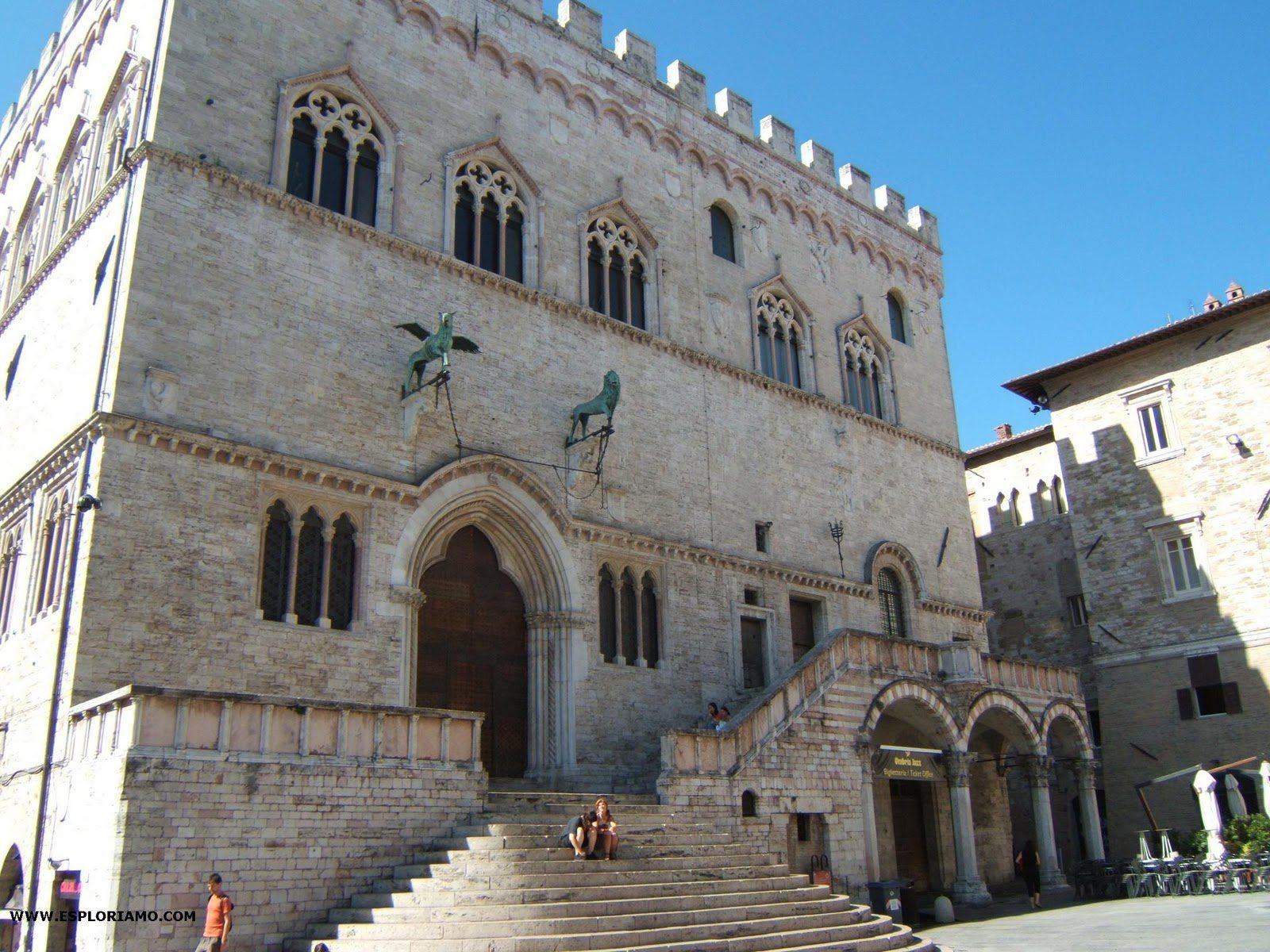Il Palazzo dei Priori si erge in Piazza IV Novembre e lungo un lato di Corso Vannucci, nel pieno centro storico di Perugia. L’imponente edificio salta subito all’occhio per la sua maestosità e rappresenta una superba espressione architettonica dello spirito comunale locale. Si tratta di uno dei monumenti simbolo della città di Perugia.
E’ oggi sede del Comune di Perugia e dalla Galleria Nazionale dell’Umbria, oltre che delle due principali corporazioni medievali note come il Nobile Collegio della Mercanzia e il Nobile Collegio del Cambio.
Il Palazzo dei Priori: cosa vedere
Il Palazzo dei Priori fu costruito in diverse fasi tra il XIII e il XV secolo. Le asimmetrie e l’andamento irregolare della facciata si spiegano proprio attraverso la realizzazione a gradi, le aggiunti e i rimaneggiamenti successivi. Note ai perugini sono ad esempio le vicissitudini dei suoi merli: il perimetro merlato del tetto del palazzo, simbolo nel potere indipendente del comune, venne fatto demolire dai pontefici nel 1610 a dimostrazione della superiorità del potere della Chiesa Romana, per poi essere ricostruiti solo con l’Unità d’Italia.
La sua massa severa, tutta chiusa nella veste di pietra squadrata e appena illeggiadrita dai due ordini di bellissime trifore gotiche che si prolungano in serrata fuga sul lato più lungo, s’immette nella piazza come un enorme bastione. Gli fa riscontro con la sua grigia e grezza muraglia il fianco della Cattedrale, che si leva di fronte alla sua alta gradinata, dalla quale gestisce la grande statua bronzea di Papa Giulio III, eretta nel 1555 dai perugini riconoscenti. Su Corso Vannucci, il Palazzo si adorna di un portale ornato come quello di una cattedrale, il Portale Maggiore o Portale delle Arti, costruito nel 1346 e ricco di decorazioni scultoree.
Da questo portale si entra al Palazzo dei Priori attraverso un atrio dal quale si può salire la scalinata che conduce alla Galleria Nazionale, con la sua immensa collezione di opere tra le più belle e significative di tutta l’arte umbra, comprese alcune tavole del Perugino, l’artista che con la purezza del disegno ed il soave sentimento del colore ci ha dato la più felice espressione della grazia e della dolcezza dell’Umbria. Per saperne di più, leggi l’articolo che abbiamo dedicato alla Galleria Nazionale dell’Umbria
Inoltre recatevi nella Sala dei Notari, cuore della vita istituzionale perugina e porzione più antica dell’edificio, per ammirarne gli splendidi affreschi.
Visita alla Sala Dei Notari del Palazzo dei Priori
Alla Sala dei Notari si accede direttamente da Piazza IV Novembre, attraverso la maestosa scalinata che conduce al portone gotico sormontato dal Grifo e dal Leone, simboli della città di Perugia e dei Guelfi. Si tratta di copie, poiché gli originali sono conservati all’interno della Galleria Nazionale per il loro alto valore artistico: si tratta infatti delle più antiche opere di grandi dimensioni realizzate in bronzo nel periodo medievale. Varcando il portale si entra nella suggestiva Sala, celebre soprattutto per i suoi affreschi variopinti.
Essa nasceva come sede per le assemblee popolari del libero comune di Perugia e fino al 1582 era conosciuta con il nome di Sala del Popolo. In quella data cambiò uso e denominazione: divenne infatti la sede della corporazione Arte dei Notai e da qui prese il suo nome attuale. Come il palazzo, gli elementi originali della sala vennero alterati durante il dominio pontificio, per poi essere restaurati e ripristinati dopo il 1860. Gli affreschi originali sono andati per la maggior parte perduti, ridipinti o integrati da Matteo Tassi (1885) per le loro cattive condizioni con cicli allegorici, leggende, storie bibliche e vari stemmi tra cui lo stemma di Braccio Fortebraccio che campeggia nella parete di fondo. La vasta sala rettangolare è sostenuta da otto poderosi arconi trasversali a tutto sesto e lungo il suo perimetro sono stati sistemati stalli e sedili, ricostruiti sui modelli originali del Cinquecento.
La sala è liberamente accessibile dal martedì alla domenica, con i seguenti orari: 9:00-13:00 e 15:00-19:00. Oltre alla giornata di chiusura settimanale del lunedì, si sottolinea che l’accesso alla sala può essere interdetto in occasione di convegni, concerti o manifestazioni particolari. L’ingresso è gratuito.
Buona visita da Bella Umbria!



Comment (0)